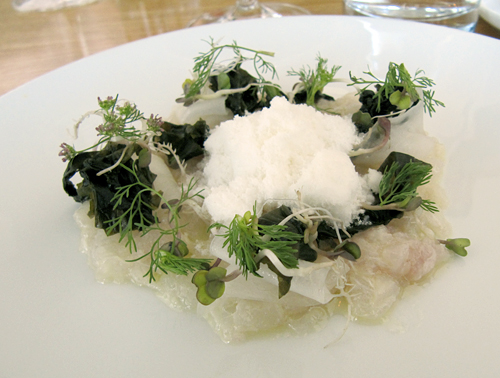It all starts -- literally -- with the egg -- this post, a life, my recent meal at Commis, a 10-month-old restaurant in Piedmont, Oakland. An egg is a pretty perfect way to begin dinner, especially when, in the case of an inspired amuse-bouche, it evokes breakfast: a poached yolk the color of a setting sun couched in an onion soup. A smear of pureed dates lurked below the surface. Tidy piles of chive clippings and crunchy steel-cut oats flanked the yolk. Even though most of my mornings start with a banana, a very early stumble down Capp Street, and a Gatorade after the gym, one bite made me think of a day beginning, a breakfast on nice plates in a room with a lot of sun and a view of a garden. From the toastiness of the oats, to the sweet, effusive jam-like quality of the dates, and the egg's richness, the elements reconfigured signifiers of breakfast without directly referencing the preparations I usually associate with the meal. It was highbrow, thoughtful, and slightly futuristic, though still comforting and cozy. The dish was what it was; whether or not my experience reflected the chef's intent was totally unimportant. I took about five minutes to eat less than two ounces of perfect lovely food, an Ice Age by my standards. Indeed, it was a very good start.
All dishes aim to satisfy. Some aim to challenge too, to make you think in the same way you're taught to pore over paintings, short stories, and films. To say chefs who cook for our brains as well as our bellies make art and not food is silly; food is a necessity, not a privilege, and the satisfaction we get from any food -- whether a carrot stick or an amuse-bouche prepared with a quarter-ton of expensive machinery -- begins with that need. That's what makes it so exciting, and kind of marvelous to behold, the continuum of agricultural and technological advances, cultural shifts, geographic realities, and economic changes that have taken us from raw mammoth to Manresa -- where Commis chef James Syhabout incidentally once toiled. The diner's role is much like that of a film or theater audience's. Participation is a function of showing up and consuming. Whether you detach and enjoy, or think about why everything is the way it is and why you're seeing it the way you're seeing it, your involvement reveals you.

Halibut tartare with coriander snow
Take the halibut, which I ate after the egg. The menu listed local halibut tartare with ginger, Meyer lemon vinaigrette, coriander snow, pickled kelp, and sprouting radish. It came as a slippery translucent mass quivering on an over-sized white plate, delicious, squishy, sparkly, salty, gravelly things bobbing together; the "snow" was crumbles of coriandar-infused ice, crunching lightly and melting with each slurp. It was good as food, the flavors supremely balanced, harmonious, but it became magical because it captured my imagination. As I was enjoying it, I stopped thinking about halibut, ginger, a salad dressing -- the components that had been cut, prepped, and positioned on the plate -- and simply let myself eat surf. The aroma wafting above the plate was the air on a good beach, light and effervescent. My fork was like my seven-year-old feet on vacation, splashing through a tide pool in Northern Florida. I thought about the last time I went to the beach. It was a while ago, and I couldn't even remember when I'd been exactly, or what I'd done there. I live perilously close to the ocean, and yet I go to the beach three times a year, and even then only occasionally set foot in the water. After the halibut, that may change.
With its modern sensibility and artful, gently Wonka-esque approach to food, Commis feels like a lighter, brighter counterpart to Coi in San Francisco. A few months ago, I ate a magnificent meal at Coi. At the same time, the restaurant's dark and shadowy digs, stiff be-suited waiters with hushed voices purring all around, and plaintive indie-folk jams emanating ever so lushly from unseen stereo speakers made for a vaguely funereal climate. The broad show of restraint that made the innovative food so spectacular and subtle had me wincing self-consciously every time my fork glanced lightly off a plate. In contrast, Commis -- from the counters, to the walls, aprons, and windows -- is all whites and silvers -- sleek and minimal, yet airy, fresh-feeling, and just welcoming enough. You get the sense that you're floating off a page in a glossy magazine. My girlfriend's dad sat at the end of our table wearing a dark grey suede blazer and a light blue shirt. His hair is whiter than coriander snow. I took a picture of him with a glass of the wine he brought and he was so excited about the shot that he showed it to the waiter.
